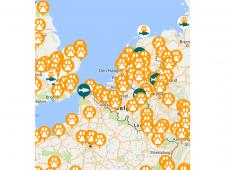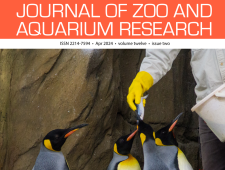EAZA Ex situ Programmes (EEPs) are population management programmes for animal species that are managed by EAZA Members. The aim of EEPs aim is to have and maintain healthy populations of healthy animals within EAZA and beyond. Together with Regional Collection Plans and Long-term Management Plans, EEPs are one of the pillars of EAZA's population management structure. Currently EAZA manages programmes for over 400 different species. A selection of these EEPs are showcased on this website. Click on the EEPs below to learn more about the programmes' different conservation roles, which conservation organisations they are partnering with, the number of animals that are in the programme, and more.
If you are looking for information about an EEP that does not have its own EEP page yet, feel free to contact us.
EAZA Member staff with a Member Area account can click on the link on each EEP page for more detailed information, such as calls for action and relevant documents.
EEP pages
Invertebrates, fish and other aquatics
• Desertas wolf spider (Hogna ingens)
• Gooty sapphire ornamental spider (Poecilotheria metallica)
• Poeciliids (Poeciliidae)
• Pupfishes (Cyprinodontidae inc. Aphaniidae)
• Seychelles giant millipede (Sechelleptus seychellarum)
• Toothcarps (Valenciidae)
Amphibians
- Montseny brook newt (Calotriton arnoldi)
- Mountain chicken frog (Leptodactylus fallax)
Reptiles
• Egyptian tortoise (Testudo kleinmanni)
• European pond turtle (Emys orbicularis)
• Galapagos giant tortoise (Chelonoidis nigra species complex)
• Henkel’s leaf-tailed gecko (Uroplatus henkeli)
• Mauremys sps (Mauremys annamensis, M. mutica, M. nigricans & M. sinensis)
• Ploughshare tortoise (Astrochleys yniphora)
• Roti Island snake-necked turtle (Chelodina mccordi)
Birds
• African penguin (Spheniscus demersus)
• Black hornbill (Anthracoceros malayanus)
• Black-winged myna complex (Acridotheres melanopterus, A. tricolor, A. tertius)
• Dalmatian pelican (Pelecanus crispus)
• Emei Shan liocichla (Liocichla omeiensis)
• Great hornbill (Buceros bicornis)
• Hill mynas complex (Gracula spp)
• Javan green magpie (Cissa thalassina)
• Gentoo penguin (Pygoscelis papua)
• Grebe (Podicipedidae spp)
• Humboldt penguin (Spheniscus humboldti)
• King penguin (Aptenodytes patagonicus)
• Lesser white-fronted goose (Anser erythropus)
• Magellanic penguin (Spheniscus magellanicus)
• Meller’s duck (Anas melleri)
• Red-billed chough (Pyrrhocorax pyrrhocoraxi)
• Rockhopper penguin (Eudyptes moseleyi and Eudyptes chrysocome)
• Rüppell’s vulture (Gyps rueppelli)
• Scaly-sided merganser (Mergus squamatus)
• Santa Cruz ground dove (Alopecoenas sanctaecrucis)
• Scops owls (Otus spp)
• Seaduck (Somateria, Histrionicus, Melanitta, Clangula and Polysticta spp)
• Snowy owl (Bubo scandiacus)
• Ural owl (Strix uralensis)
• White-winged duck (Asarcornis scutulata)
Mammals - Primates
• Aye aye (Daubentonia madagascariensis)
• Black-crested mangabey (Lophocebus aterrimus)
• Blue-eyed black lemur (Eulemur flavifrons)
• Buffy headed marmoset (Callithrix flaviceps)
• Buffy tufted ear marmoset (Callithrix aurita)
• Coquerel's sifaka (Propithecus coquereli)
• Cotton-top tamarin (Saguinus oedipus oedipus)
• Emperor tamarin (Saguinus imperator)
• Goeldi's monkey (Callimico goeldii)
• Guinea baboon (Papio papio, P. anubis, P. cynocephalus)
• Hamadryas baboon (Papio hamadryas)
• Invasive marmoset (Callithrix jacchus and Callithrix penicillata)
• Lar gibbon (Hylobates lar)
• Lion-tailed macaque (Macaca silenus)
• Northern galago (Galago senegalensis)
• Pileated gibbon (Hylobates pileatus)
• Pygmy marmoset (Cebuella pygmaea)
• Red-bellied lemur (Eulemur rubriventer)
• Roloway monkey (Cercopithecus roloway)
• Siamang (Symphalangus syndactylus)
• Silvery marmoset (Mico argentatus)
• White-fronted marmoset (Callithrix geoffroyi)
Mammals - Carnivores
• Maned wolf (Chrysocyon brachyurus)
• Spotted hyena (Crocuta crocuta)
• Striped hyena (Hyaena hyaena)
Mammals - Ungulates
• Anoa (Bubalus depressicornis)
• Aoudad (Ammotragus lervia)
• Bactrian wapiti (Cervus hanglu bactrianus)
• Blesbok (Damaliscus pygargus phillipsi)
• Chinese goral (Naemorhedus griseus)
• Cuvier's gazelle (Gazella cuvieri)
• Eastern black rhino (Diceros bicornis michaeli)
• Eld’s deer (Rucervus eldii)
• European bison (Bison bonasus)
• Forest reindeer (Rangifer tarandus fennicus)
• Gaur (Bos gaurus)
• Giraffe (Giraffa camelopardalis)
• Grevy's zebra (Equus grevyi)
• Hartmann's mountain zebra (Equus zebra hartmannae)
• Lesser chevrotain (Tragulus javanicus and Tragulus kanchil)
• Malayan tapir (Tapirus indicus)
• Michie's tufted deer (Elaphodus cephalophus michianus)
• Mhorr gazelle (Nanger dama mhorr)
• Musk ox (Ovibos moschatus)
• Okapi (Okapia johnstoni)
• Przewalski's horse (Equus przewalskii)
• Somali wild ass (Equus africanus somalicus)
• Southern pudu (Pudu puda)
• Takin (Budorcas taxicolor bedfordi, B. t. taxicolor, B. t. tibetana)
• Turkmenian kulan (Equus hemionus kulan)
• Turkmenian markhor (Capra falconeri heptneri)
• Urial (Ovis orientalis arkal and bochariensis)
• Visayan spotted deer (Rusa alfredi)
• White rhinoceros (Ceratotherium simum)
Mammals - Marine
Mammals - Other
• Koala (Phascolarctos cinereus)
Programme roles
Each EEP has its own set of roles that describe the benefits of the EEP to the overall conservation of the species, as well as to the zoos and aquariums and their visitors. These roles can be served either simultaneously or consecutively, and are divided in three categories: direct conservation roles, indirect conservation roles and non-conservation roles.
Direct conservation roles
An EEP can have a direct conservation role if ex situ management is identified as (one of) the essential action(s) for the conservation of that species by the conservation community. Direct conservation roles are generally aimed to address the causes of primary threats to a species in the wild, offset the effects of these threats, buy time when a wild population is declining at a rapid rate, or restore wild populations. Descriptions of these roles are based on the IUCN SSC Guidelines on the Use of Ex situ Management for Species Conservation and Appendix I of the Amphibian Ark Conservation Needs Assessment Process.
Indirect conservation roles
There are situations in which the zoo and aquarium community can contribute to conservation by making available its expertise, knowledge, materials, staff, fundraising, etc. to help implement in situ conservation actions, and/or by carrying out general awareness and conservation education activities aimed at the zoo-visiting public. Programme roles related to these situations are called indirect conservation roles, as they are helpful and needed, but not immediately essential the conservation of the species.
Non-conservation roles
While the conservation of wildlife is one of the central missions of EAZA, ex situ populations of species can also be managed for different reasons. One example of a programme role that is not related to conservation is the education of visitors on topics such as specific aspects of the species' biology. A species can also be very suited, for example, to let zoo staff gain experience in preparation of taking on a species with more complicated husbandry requirements.
 This work is supported by the European Union LIFE NGO funding programme. The European Union is not responsible for the views displayed in publications and/or in conjunction with the activities for which the grant is used.
This work is supported by the European Union LIFE NGO funding programme. The European Union is not responsible for the views displayed in publications and/or in conjunction with the activities for which the grant is used.




